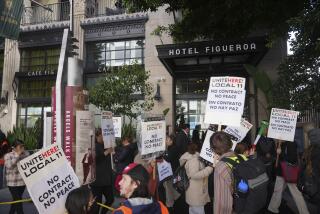Hotel Industry’s Plans Confirm Recovery--and More
In the wake of September’s terrorist attacks, no industry was hit as severely as travel. Hotels and resorts languished as business travelers and vacationers stayed home; airlines curtailed schedules.
The travel and tourism economy is still slow almost seven months later. But Marriott International Inc., one of the world’s largest hotel groups, is adding 25,000 to 30,000 rooms this year and the same in 2003, a 12% increase in its chain of 2,500 hotels worldwide.
Chairman J. Willard Marriott Jr. is confident that business travel soon will return to a steady growth pattern. “We are starting to see interesting things, short-term corporate meetings. Companies will call up and say we need 300 rooms in two weeks. They want a meeting to talk about where they’re going,” he says.
Marriott is not alone. Starwood Hotels & Resorts Worldwide Inc., owner of the Sheraton, Westin and other hotel brands, is adding 14,600 rooms this year and the same number next year, a 7% increase. Hilton Hotels Corp. will add 150 hotels to its franchised system. Six Continents, the London-based owner of Holiday Inns and other hotel brands, is expanding, as are Four Seasons Hotels Inc. and other chains.
Demand for hotel rooms is a sure indicator of recovery from recession--and more. It is a sign that the once-mundane hotel industry is now a force in the global economy and a business driven by information and knowledge.
“Business investment is extremely important to the hotel business,” Marriott says. If companies resume investing in new computers and machinery, that will lift the hotel business, he says, describing the quickening dance of recovery. “When companies are buying new equipment, their consultants are on the road, their people are on the road looking at new systems, salesmen are on the road.”
Leisure travel, particularly internationally, shows signs of coming back. “Japanese tour operators assure us that their tourists and businessmen will be traveling again by May,” Marriott says.
However, the outlook this summer remains dim for European tourists returning to the United States, particularly to Florida, in the same numbers as in recent years, and for American travelers going to Europe.
Marriott, who turned 70 last week, has presided over the development of the Bethesda, Md.-based company’s hotel business from its start in 1957. That’s when the family firm opened its first hotel in Arlington, Va., as an offshoot of its Hot Shoppes chain of restaurants, begun by Marriott’s parents with a root beer stand in 1927 in Washington.
The restaurant business was sold in 1985 and the company, with occasional forays into amusement parks, cruise lines and travel agencies, has concentrated on the hotel trade.
An Indicator of Global Economic Development
In 2001, Marriott racked up $20 billion in sales, a 1% increase from the previous year despite a recession and the terrorist attacks that destroyed Marriott’s hotel at the World Trade Center and closed another nearby in the Wall Street area. (The latter has reopened.) Profit was down 16% in 2001.
Marriott has seen the hotel industry develop from a frag-
mented field of many small companies to a worldwide business led by chains that can offer accom-
modations in several styles and at various prices. Marriott, for exam-
ple, owns the luxury Ritz-Carlton chain as well as the economy-class Fairfield Inns. Hilton ranges from top-priced resort hotels to lower-end Hampton Inns.
The hotel business has become an indicator of global economic development. When middle classes and commercial relationships are developing, use of hotels goes with the territory. “We have 35 hotels in China, five more under construction and we’re going into India,” Marriott says.
Starwood Hotels boasts of its plans to open Westin and Sheraton hotels in Vietnam, Bangladesh, Poland, Syria and Egypt.
Such ambitious building programs are possible because construction and ownership of the hotels are financed by local or international investors. The hotel companies offer their names, their management and their reservations systems to bring in customers.
The hotel business thus is an example of leveraging the value of information and knowledge; the industry has developed communications systems that can attract and direct customers, and management systems that can run a complex for thousands of guests and employees.
The fee structure typical of a hotel company’s management contract illustrates how important Marriott’s role is. On top of a base management fee of 3% to 4% of a hotel’s gross revenue, Marriott can earn an incentive fee that can be 15% to 30% of the hotel’s profit after the owner takes an 8% to 12% return off the top.
It’s a business that puts a premium on consistency, says John Arabia, a director of Green Street Advisors, a Newport Beach research firm that covers the real estate and lodging industries.
“Consumers commonly make purchases without prior experience of a specific hotel, so the brand name has to convey expectations of quality and service,” Arabia says.
Some chains such as Holiday Inn have suffered when franchised locations have not lived up to quality standards. Even now, Starwood is embarked on a program to bring a consistent level of quality back to the Sheraton chain, which it acquired in 1998. If Starwood can improve Sheraton, the payoff will be an extra $55million in annual earnings, says analyst Joyce Minor of Lehman Bros. investment firm.
Marriott Sees Room for Growth Overseas
Marriott has taken pains to protect its brand name, stipulating to owners the kind of expenditures necessary to keep hotel facilities up to snuff, Arabia says.
So Chairman Marriott is eager to add more rooms, particularly overseas. “I can’t have enough hotel rooms in London,” he says. “I want more in Europe and in Asia and Latin America.” The more hotel rooms, the greater will be travelers’ awareness of the Marriott brand names, and thus the greater the occupancy rate, Marriott explains.
Typically, Marriott hotels break even at 60% occupancy. Hurt by recession, the firm averaged just more than 70% last year for Marriott hotels, down 9% from the more prosperous year 2000.
Expansion Seen in the Longer Term
In Southern California, Marriott opened its first hotel in 1973, at Los Angeles International Airport, just as rising gasoline prices threw a roadblock up for the travel business. “Occupancy was only 25% when we started out,” Marriott recalls.
Now the company has more than 80 facilities under various brand names in the region and is adding hotels in Ventura, Burbank, Del Mar, downtown San Diego, Anaheim and Cypress, plus a new luxury hotel, Colony in Laguna Beach. It opened the Renaissance Hollywood Hotel just before this month’s Academy Awards ceremony.
The hotel business overall may not be robust in the near term. The outlook is for 2% growth in demand this year, half the growth rate of the late ‘90s, reports Smith Travel Research, a Henderson, Tenn., firm that covers the industry. Marriott’s longer-term prediction is more expansive. “Travel will grow 4% to 5% a year long term,” he says. And the company will grow faster, he says, because it will continue to add properties.
Few would have predicted last fall in the wake of terrorist attacks on top of a recession that hotel companies would be talking of expansion so soon. Still, the stocks of all the major hotel companies have rebounded strongly from their low points after Sept. 11. Marriott stock is up 39%, Starwood is up 78% and Hilton is up 67% since trading resumed after the attacks.
Clearly, some investors can spot a trend and growing opportunity.
*
James Flanigan can be reached at [email protected].
More to Read
Inside the business of entertainment
The Wide Shot brings you news, analysis and insights on everything from streaming wars to production — and what it all means for the future.
You may occasionally receive promotional content from the Los Angeles Times.










